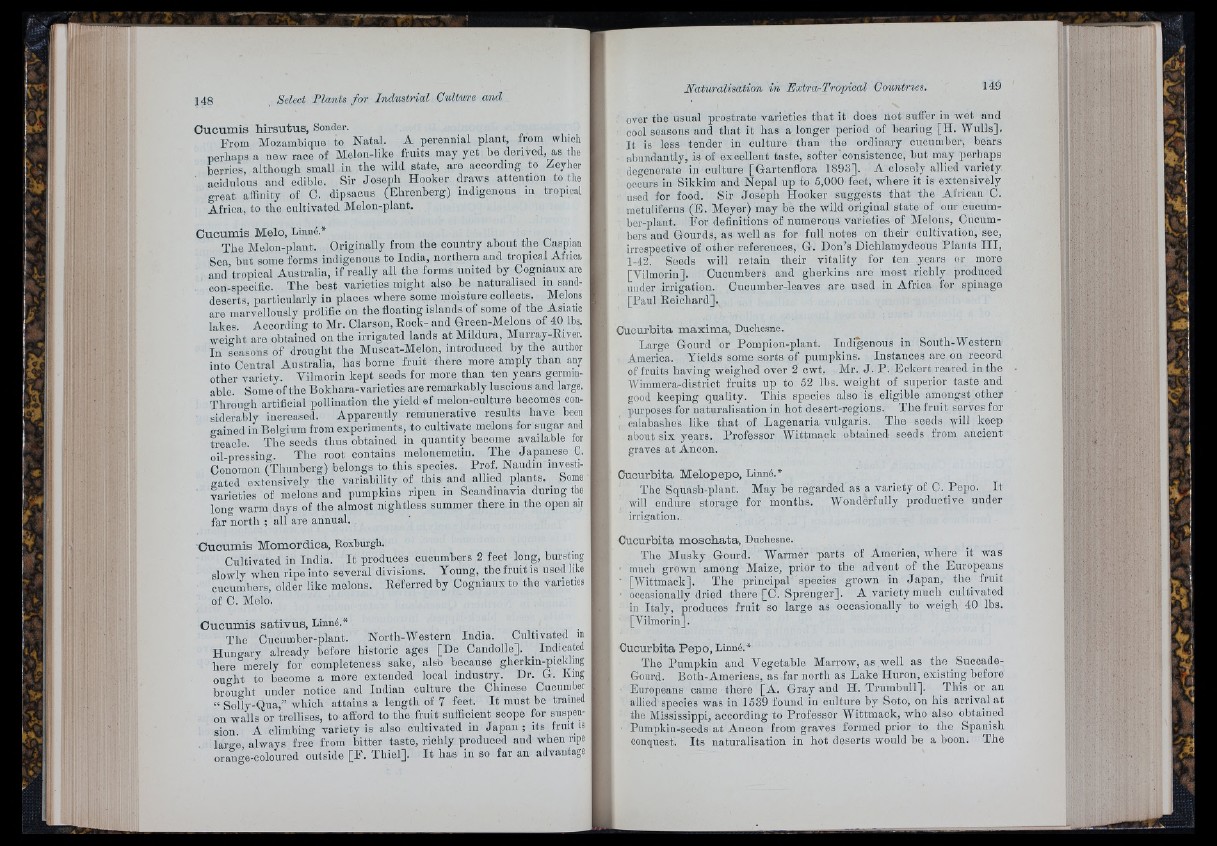
Sdect Plants fo r Industrial Culture and
C u c u m i s h i r s u tu s , Sonder.
From Mozambique to iSiatal. A perennial plant, from whioli
perhaps a new race of Melon-like fruits may yet be derived, as the
berries, altliough small in the wild state, are according to Zeyher
acidulous and edible. Sir Joseph Hooker draws attention to the
great affinity of C. dipsaous (Ehrenberg) indigenous iii tropical
Africa, to the cultivated Melon-plant.
C u c u m i s M e lo , Linné.*
Tlie Melon-plant. Originally from tlie country abont the Caspian
Sea but some forms indigenous to India, northern and tropical Africa
and’tropioal Australia, if really all the forms united by Cogniaux are
con-specific. The best varieties might also be naturalised in sand-
deserts, particularly in places wliere some moisture collects. Melons
are marvellously prolific on the floating islands of some of the Asiatic
lakes According to Mr. Clarsou, Rock- aud Green-Melons of 40 lbs.
weight are obtained on the irrigated lands a t Mildura, Miirray-River.
In seasons of drought the Muscat-Melon, introduced by the author
into Central Australia, has borne fruit there more amply than any
other variety. Vilmorin kept seeds for more than ten years germm-
ahle. Some of the Bokhara-varieties are remarkably luscious and large.
Thronn-h artificial pollination the yield of melon-oulture becomes considerably
increased. Apparently remunerative results have been
o-ained iu Belgium from experiments, to cultivate melons for sugar and
treacle. The seeds thus obtained in quantity become availalile for
oil-pressing. The root contains melonemetin. The Japanese C,
Conoinon (Tlumberg) belongs to this species. Prof. Naudin investigated
extensively the variability of this and allied plants. Some
varieties of melons and pumpkins ripen in Scandinavia during the
long warm days of the almost nightless summer tnere in the open air
far north ; all are annual.
C u c u m i s M om o rd io a , Roxburgh.
Cultivated in India. I t produces cucumbers 2 feet long, bursting
slowly when ripe into several divisions. Young, the fruit is used lib
ciioumliers, older like melons. Referred by Cogniaux to the varieties
of C. Melo.
C u c u m i s s a t iv u s , Linné.*
The Cnciimber-plant. North-Western India. Cultivated m
Hungary already before historic ages [De Candolle]. Indicated
here merely for completeness sake, alsb because gherkin-piokling
ought to become a more extended local industry. Dr. G. Kmg
bromriit under notice and Indian culture the Chinese Cuouinber
“ Sofly-Qua,” which attains a length of 7 feet. I t must be trained
on walls or trellises, to afford to the frnit sufficient scope for suspension.
A climbing variety is also cultivated in J a p a n ; its fruit is
laro-e always free from bitter taste, richly produced and when ripe
orange-coloured outside [F . Thiel], I t has in so far an advantage
over the usual prostrate varieties th a t it does not suffer in wet and
cool seasons and th a t it has a longer period of bearing [H. Wnlls].
It is less tender in culture than the ordinary cucumber, bears
abundantly, is of excellent taste, softer consistence, but may perhaps
degenerate in culture [Gartenflora 1893]. A closely allied variety
occurs in Sikkim and Nepal up to 5,000 feet, where it is extensively
used for food. Sir Joseph Hooker suggests th a t the Afrioiin C.
metiiliferns (E . Meyer) may be the wild original state of oiir cncum-
ber-plaiit. For definitions of numerous varieties of Melons, Cucumbers
and Gourds, as well as for full notes on their cultivation, see,
irrespective of other references, G. Don’s Dichlamydeons Plants I I I ,
1-42. Seeds will retain their vitality for ton years or more
[Vilmorin]. Cucumbers and gherkins arc most richly produced
under irrigation. Cucumhor-leaves are used in Africa for spinage
[Paul Reichard].
Cucurbita m a x im a , Duchesne.
Large Gourd or Pompion-plant. Indigenous in South-Western
America. Yields some sorts of pumpkins. Instances are on record
of fruits having weighed over 2 cwt. Mr. J . P. Eckert reared in the
Wimmera-district fruits up to 52 lbs. weight of superior taste and
good keeping quality. This species also is eligible amongst other
jiurposes for naturalisation in hot desert-regions. The fruit serves for
calabashes like th a t of Lagenaria vulgaris. The seeds will keep
about six years. Professor Wittmack obtained seeds from ancient
graves a t Ancon.
Cucurbita Melopepo, Linné.*
The Squash-plaiit. May he regarded as a variety of C. Pepo. I t
will endure storage for months. Wonderfully productive under
irrigation.
Cucurbita m o s c h a ta , Duchesne.
The Musky Gourd. Warmer parts of America, whore it was
much grown among Maize, prior to tho advent of the Europeans
■ [Wittmack]. The principal species grown in Japan, tlie^ fruit
occasionally dried there [C. Sprenger]. A variety much cultivated
in Italy, produces fruit so large as occasionally to weigh 40 lbs.
[Vilmorin].
Cucurbita P e p o , Linné.*
The Pumpkin and Vegetable Marrow, as well as the Succade-
Goiird. Both-Americas, as far north as Lake Huron, existing before
Europeans came there [A. Gray and II. Trumbull]. I his or an
allied species was in 1639 found in culture by Soto, on liis arrival a t
the Mississippi, according to Professor Wittmack, who also obtained
Pumpkin-seeds a t Ancon from graves formed prior to the Spanish
conquest. Its naturalisation in hot deserts would be a boon. The